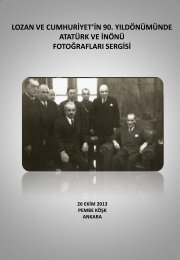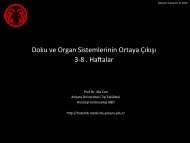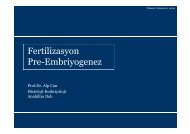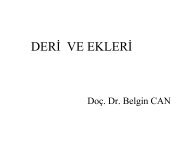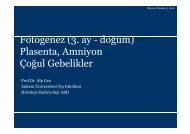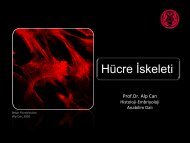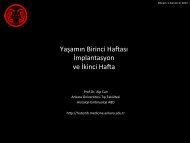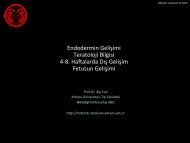dosya indir - ankaratiphastaneleri
dosya indir - ankaratiphastaneleri
dosya indir - ankaratiphastaneleri
Create successful ePaper yourself
Turn your PDF publications into a flip-book with our unique Google optimized e-Paper software.
Avrupa Resüsitasyon Konseyi 2005 Resüsitasyon K›lavuzu<br />
S125<br />
31. Samson R, Berg R, Bingham R, Pediatric Advanced Life Support<br />
Task Force ILCoR. Use of automated external defibrillators<br />
for children: an update. An advisory statement from the Pediatric<br />
Advanced Life Support Task Force of the International Liaison<br />
Committee on Resuscitation. Resuscitation 2003;<br />
57:237-43.<br />
32. Jorgenson D, Morgan C, Snyder D, et al. Energy attenuator for<br />
pediatric application of an automated external defibrillator. Crit<br />
Care Med 2002; 30:S145-7.<br />
33. Tang W, Weil MH, Jorgenson D, et al. Fixed-energy biphasic<br />
waveform defibrillation in a pediatric model of cardiac arrest<br />
and resuscitation. Crit Care Med 2002; 30:2736-41.<br />
34. Berg RA, Chapman FW, Berg MD, et al. Attenuated adult biphasic<br />
shocks compared with weight-based monophasic shocks<br />
in a swine model of prolonged pediatric ventricular fibrillation.<br />
Resuscitation 2004; 61:189-97.<br />
35. Berg RA, Samson RA, Berg MD, et al. Better outcome after pediatric<br />
defibrillation dosage than adult dosage in a swine model<br />
of pediatric ventricular fibrillation. J Am Coll Cardiol 2005;<br />
45:786-9.<br />
36. Rossano JQ, L. Schiff, MA. Kenney MA. Atkins DL. Survival is<br />
not correlated with defibrillation dosing in pediatric out-ofhospital<br />
ventricular fibrillation. Circulation 2003; 108:320-1.<br />
37. Clark CB, Zhang Y, Davies LR, Karlsson G, Kerber RE. Pediatric<br />
transthoracic defibrillation: biphasic versus monophasic waveforms<br />
in an experimental model. Resuscitation 2001; 51:159-<br />
63.<br />
38. Schneider T, Martens PR, Paschen H, et al. Multicenter, randomized,<br />
controlled trial of 150-J biphasic shocks compared with<br />
200- to 360-J monophasic shocks in the resuscitation of outof-hospital<br />
cardiac arrest victims. Optimized Response to Cardiac<br />
Arrest (ORCA) Investigators. Circulation 2000; 102:1780-<br />
7.<br />
39. Faddy SC, Powell J, Craig JC. Biphasic and monophasic shocks<br />
for transthoracic defibrillation: A meta analysis of randomised<br />
controlled trials. Resuscitation 2003; 58:9-16.<br />
40. van Alem AP, Chapman FW, Lank P, Hart AA, Koster RW. A<br />
prospective, randomised and blinded comparison of first<br />
shock success of monophasic and biphasic waveforms in outof-hospital<br />
cardiac arrest. Resuscitation 2003; 58:17-24.<br />
41. Redding JS. The choking controversy: critique of evidence on<br />
the Heimlich maneuver. Crit Care Med 1979; 7:475-9.<br />
42. International Liaison Committee on Resuscitation. Part 2. Adult<br />
Basic Life Support. 2005 International Consensus on Cardiopulmonary<br />
Resuscitation and Emergency Cardiovascular Care<br />
Science with Treatment Recommendations. Resuscitation<br />
2005; In Press.<br />
43. Sirbaugh PE, Pepe PE, Shook JE, et al. A prospective, population-based<br />
study of the demographics, epidemiology, management,<br />
and outcome of out-of-hospital pediatric cardiopulmonary<br />
arrest. Ann Emerg Med 1999; 33:174-84.<br />
44. Hickey RW, Cohen DM, Strausbaugh S, Dietrich AM. Pediatric<br />
patients requiring CPR in the prehospital setting. Ann Emerg<br />
Med 1995; 25:495-501.<br />
45. Reis AG, Nadkarni V, Perondi MB, Grisi S, Berg RA. A prospctive<br />
investigation into the epidemiology of in-hospital pediatric<br />
cardiopulmonary resuscitation using the international Utstein<br />
reporting style. Pediatrics 2002; 109:200-9.<br />
46. Young KD, Gausche-Hill M, McCl ng CD, Lewis RJ. A prospective,<br />
population-based study of the epidemiology and outcome<br />
of out-of-hospital pediatric cardiopulmonary arrest. Pediatrics<br />
2004; 114:157-64.<br />
47. Richman PB, Nashed AH. The etiology of cardiac arrest in children<br />
and young adults: special considerations for ED management.<br />
Am J Emerg Med 1999; 17:264-70.<br />
48. Engdahl J, Bang A, Karlson BW, Lindqvist J, Herlitz J. Characteristics<br />
and outcome among patients suffering from out of hospital<br />
cardiac arrest of non-cardiac aetiology. Resuscitation<br />
2003; 57:33-41.<br />
49. Carcillo JA. Pediatric septic shock and multiple organ failure.<br />
Crit Care Clin 2003; 19:413-40, viii.<br />
50. Eberle B, Dick WF, Schneider T, Wisser G, Doetsch S, Tzanova<br />
I. Checking the carotid pulse check: diagnostic accuracy of first<br />
responders in patients with and without a pulse. Resuscitation<br />
1996; 33:107-16.<br />
51. Moule P. Checking the carotid pulse: diagnostic accuracy in<br />
students of the healthcare professions. Resuscitation 2000;<br />
44:195-201.<br />
52. Lapostolle F, Le Toumelin P, Agostinucci JM, Catineau J, Adnet<br />
F. Basic cardiac life support providers checking the carotid pulse:<br />
performance, degree of conviction, and influencing factors.<br />
Acad Emerg Med 2004; 11:878-80.<br />
53. Frederick K, Bixby E, Orzel MN, Stewart-Brown S, Willett K.<br />
Will changing the emphasis from 'pulseless' to 'no signs of circulation'<br />
improve the recall scores for effective life support<br />
skills in children? Resuscitation 2002; 55:255-61.<br />
54. Park C, Bahk JH, Ahn WS, Do SH, Lee KH. The laryngeal mask<br />
airway in infants and children. Can J Anaesth 2001; 48:413-7.<br />
55. Hedges JR, Dronen SC, Feero S, Hawkins S, Syverud SA, Shultz<br />
B. Succinylcholineassisted intubations in prehospital care. Ann<br />
Emerg Med 1988; 17:469-72.<br />
56. Murphy-Macabobby M, Marshall WJ, Schneider C, Dries D.<br />
Neuromuscular blockade in aeromedical airway management.<br />
Ann Emerg Med 1992; 21:664-8.<br />
57. Sayre M, Weisgerber I. The use of neuromuscular blocking<br />
agents by air medical services. J Air Med Transp 1992; 11:7-<br />
11.<br />
58. Rose W, Anderson L, Edmond S. Analysis of intubations. Before<br />
and after establishment of a rapid sequence intubation protocol<br />
for air medical use. Air Med J 1994; 13:475-8.<br />
59. Sing RF, Reilly PM, Rotondo MF, Lynch MJ, McCans JP, Schwab<br />
CW. Out-ofhospital rapid-sequence induction for intubation of<br />
the pediatric patient. Acad Emerg Med 1996; 3:41-5.<br />
60. Ma OJ, Atchley RB, Hatley T, Green M, Young J, Brady W. Intubation<br />
success rates improve for an air medical program after<br />
implementing the use of neuromuscular blocking agents.<br />
Am J Emerg Med 1998; 16:125-7.<br />
61. Tayal V, Riggs R, Marx J, Tomaszewski C, Schneider R. Rapidsequence<br />
intubation at an emergency medicine residency:<br />
success rate and adverse events during a twoyear period.<br />
Acad Emerg Med 1999; 6:31-7.<br />
62. Wang HE, Sweeney TA, O'Connor RE, Rubinstein H. Failed prehospital<br />
intubations: an analysis of emergency department courses<br />
and outcomes. Prehosp Emerg Care 2001; 5:134-41.<br />
63. Sagarin MJ, Chiang V, Sakles JC, et al. Rapid sequence intubation<br />
for pediatric emergency airway management. Pediatr<br />
Emerg Care 2002; 18:417-23.<br />
64. Kaye K, Frascone RJ, Held T. Prehospital rapid-sequence intubation:<br />
a pilot training program. Prehosp Emerg Care 2003;<br />
7:235-40.<br />
65. Wang HE, Kupas DF, Paris PM, Bates RR, Costantino JP, Yealy<br />
DM.<br />
Multivariat<br />
predictors of failed prehospital endotracheal intubation. Acad<br />
Emerg Med 2003; 10:717-24.<br />
66. Pepe P, Zachariah B, Chandra N. Invasive airway technique in<br />
resuscitation. Ann Emerg Med 1991; 22:393-403.<br />
67. Luten RC, Wears RL, Broselow J, et al. Length-based endotracheal<br />
tube and emergency equipment in pediatrics. Ann Emerg<br />
Med 1992; 21:900-4.<br />
68. Deakers TW, Reynolds G, Stretton M, Newth CJ. Cuffed endotracheal<br />
tubes in pediatric intensive care. J Pediatr 1994;<br />
125:57-62.<br />
69. Khine HH, Corddry DH, Kettrick RG, et al. Comparison of cuffed<br />
and uncuffed endotracheal tubes in young children during<br />
general anesthesia. Anesthesiology 1997; 86:627-31.<br />
70. Newth CJ, Rachman B, Patel N, Hammer J. The use of cuffed<br />
versus uncuffed endotracheal tubes in pediatric intensive care.<br />
J Pediatr 2004; 144:333-7.<br />
71. Mhanna MJ, Zamel YB, Tichy CM, Super DM. The "air leak" test<br />
around the endotracheal tube, as a predictor of postextubati-



